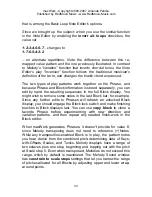
maxWerk - Copyright 2000-2007 Amanda Pehlke
Published by RedMoon Music - www.RedMoon-Music.com
47
the displays. You can have mutations occur once every bar to once
every four bars via the mutation control menu. The revert menu
tells mutation-enabled loops to go back to their original play pattern
after a certain number of bars. Make in/out bar settings for this
track's mutate function in the remaining two menus. Since pattern-
mutating counts the number of bars, not loop repetitions, between
new mutations, you might double the enabled section length if the
loop is set for half-timed play. Be sure too that the frequency of
mutating does not exceed the frequency of reverting, or you won't
hear the intended effect. Two alternative mutating styles at the
end of the mutation control menu let you add in or drop out (mask)
pattern data at the rate of one additional step-set per bar. Mutations
are not affected by automuting, but these are effective used with
Automutes to gradually introduce a loop or "devolve" its pattern.
At the bottom of the Note Editor is a field of play controls comprised
of menus and checkboxes. Steps delay shifts the loop's onset by a
selectable number of steps, the duration of which varies according
to the step resolution. The 16ths sustain on mute menu directs
Automute to switch off that part following a delay setting measured
in 16th-note durations. For example, muting a track with a sustain-
on-mute setting of 2 has the effect of cutting off the last note one
count into the following muted bar.
The velocities menu, normal by default, offers velocity treatments
that can create changing effects with each loop repetition. With
cycle enabled, velocity step numbers increment by one relative to
note steps, so that you can create a variable note-gating effect by
including velocity values of 0. The selection to rotate velocities
increments all values greater than 0 with each pass, wrapping them
around from 8 to 1. Used separately or combined via the 2 ways
selection, these functions are most effective in play-all-steps mode.
The pitch rotate menu shuffles pitches harmoniously. flip 2-6
inverts a subset of scale notes on alternate loop passes. The option
for 1-7 up 2 causes triadic tones 1-3-5 and passing tones 2-4-6 to
rotate within their tone type, but values 7 and 8 remain unchanged.






























